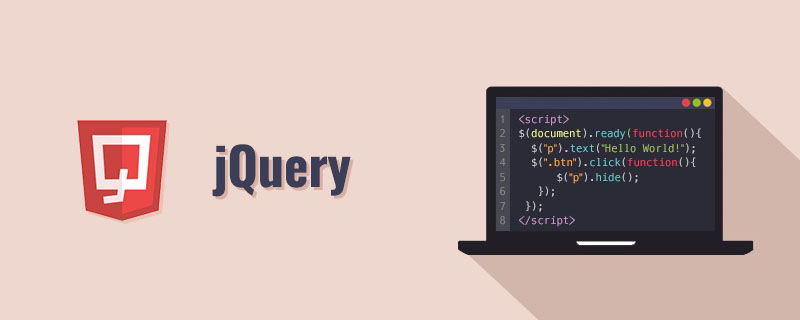Sometimes, it is necessary to simulate user operations to achieve the click effect. For example, after the user enters the page, the click event is triggered without the user having to actively click. In JQuery, simulation operations can be completed using the trigger() method. For example, you can use the following code to trigger the click event of the button with id btn. In this article, we will explain to you how JQuery simulates click events and automatically triggers events.
$('#btn').trigger("click");In this way, when the page is loaded, the desired effect will be output immediately. You can also directly abbreviate click() to achieve the same effect:
$('#btn').click();
Trigger custom events
trigger() method can not only trigger events with the same name supported by the browser, but also Trigger an event with a custom name. For example, to bind a "myClick" event to an element, the JQuery code is as follows:
$('#btn').bind("myClick", function(){
$('#test').append("<p>我的自定义事件.</p>");
});If you want to trigger this event, you can use the following code to achieve it:
$('#btn').trigger("myClick");Pass data
## The #trigger(type[,data]) method has two parameters. The first parameter is the event type to be triggered, and the second parameter is the additional data to be passed to the event processing function, passed in the form of an array. You can usually distinguish whether this event is triggered by code or user by passing a parameter to the callback function. The following is an example of passing data.$(function(){
$('#btn').bind("myClick", function(event, message1, message2){
$('#test').append( "<p>"+message1 + message2 +"</p>");
});
$('#btn').click(function(){
$(this).trigger("myClick",["我的自定义","事件"]);
}).trigger("myClick",["我的自定义","事件"]);
})Perform the default operationAfter the trigger() method triggers the event, the browser default operation will be performed. For example: $("input").trigger("focus");The above code will not only trigger the focus event bound to the element, but also cause the element itself to get focus (this is the browser's default operation). If you only want to trigger the bound focus event without performing the browser's default operation, you can use another similar method in jQuery - the triggerHandler() method. $("input").triggerHandler("focus");This method will trigger the specific event bound to the element, and at the same time cancel the browser's default operation for this event, that is, the text box will only trigger the bound focus event and will not receive focus. This article mainly introduces JQuery to simulate click events and automatically trigger events. I hope it will be helpful to everyone. Related recommendations:
js simulate click event implementation code_javascript skills
Javascript simulates click events (click links and html clicks) compatible with IE/Firefox_javascript skills
The above is the detailed content of JQuery simulates click events and automatically triggers events. For more information, please follow other related articles on the PHP Chinese website!
 jquery实现多少秒后隐藏图片Apr 20, 2022 pm 05:33 PM
jquery实现多少秒后隐藏图片Apr 20, 2022 pm 05:33 PM实现方法:1、用“$("img").delay(毫秒数).fadeOut()”语句,delay()设置延迟秒数;2、用“setTimeout(function(){ $("img").hide(); },毫秒值);”语句,通过定时器来延迟。
 axios与jquery的区别是什么Apr 20, 2022 pm 06:18 PM
axios与jquery的区别是什么Apr 20, 2022 pm 06:18 PM区别:1、axios是一个异步请求框架,用于封装底层的XMLHttpRequest,而jquery是一个JavaScript库,只是顺便封装了dom操作;2、axios是基于承诺对象的,可以用承诺对象中的方法,而jquery不基于承诺对象。
 jquery怎么修改min-height样式Apr 20, 2022 pm 12:19 PM
jquery怎么修改min-height样式Apr 20, 2022 pm 12:19 PM修改方法:1、用css()设置新样式,语法“$(元素).css("min-height","新值")”;2、用attr(),通过设置style属性来添加新样式,语法“$(元素).attr("style","min-height:新值")”。
 jquery怎么在body中增加元素Apr 22, 2022 am 11:13 AM
jquery怎么在body中增加元素Apr 22, 2022 am 11:13 AM增加元素的方法:1、用append(),语法“$("body").append(新元素)”,可向body内部的末尾处增加元素;2、用prepend(),语法“$("body").prepend(新元素)”,可向body内部的开始处增加元素。
 jquery怎么删除div内所有子元素Apr 21, 2022 pm 07:08 PM
jquery怎么删除div内所有子元素Apr 21, 2022 pm 07:08 PM删除方法:1、用empty(),语法“$("div").empty();”,可删除所有子节点和内容;2、用children()和remove(),语法“$("div").children().remove();”,只删除子元素,不删除内容。
 jquery中apply()方法怎么用Apr 24, 2022 pm 05:35 PM
jquery中apply()方法怎么用Apr 24, 2022 pm 05:35 PM在jquery中,apply()方法用于改变this指向,使用另一个对象替换当前对象,是应用某一对象的一个方法,语法为“apply(thisobj,[argarray])”;参数argarray表示的是以数组的形式进行传递。
 jquery怎么去掉只读属性Apr 20, 2022 pm 07:55 PM
jquery怎么去掉只读属性Apr 20, 2022 pm 07:55 PM去掉方法:1、用“$(selector).removeAttr("readonly")”语句删除readonly属性;2、用“$(selector).attr("readonly",false)”将readonly属性的值设置为false。
 jquery on()有几个参数Apr 21, 2022 am 11:29 AM
jquery on()有几个参数Apr 21, 2022 am 11:29 AMon()方法有4个参数:1、第一个参数不可省略,规定要从被选元素添加的一个或多个事件或命名空间;2、第二个参数可省略,规定元素的事件处理程序;3、第三个参数可省略,规定传递到函数的额外数据;4、第四个参数可省略,规定当事件发生时运行的函数。


Hot AI Tools

Undresser.AI Undress
AI-powered app for creating realistic nude photos

AI Clothes Remover
Online AI tool for removing clothes from photos.

Undress AI Tool
Undress images for free

Clothoff.io
AI clothes remover

AI Hentai Generator
Generate AI Hentai for free.

Hot Article

Hot Tools

ZendStudio 13.5.1 Mac
Powerful PHP integrated development environment

mPDF
mPDF is a PHP library that can generate PDF files from UTF-8 encoded HTML. The original author, Ian Back, wrote mPDF to output PDF files "on the fly" from his website and handle different languages. It is slower than original scripts like HTML2FPDF and produces larger files when using Unicode fonts, but supports CSS styles etc. and has a lot of enhancements. Supports almost all languages, including RTL (Arabic and Hebrew) and CJK (Chinese, Japanese and Korean). Supports nested block-level elements (such as P, DIV),

SecLists
SecLists is the ultimate security tester's companion. It is a collection of various types of lists that are frequently used during security assessments, all in one place. SecLists helps make security testing more efficient and productive by conveniently providing all the lists a security tester might need. List types include usernames, passwords, URLs, fuzzing payloads, sensitive data patterns, web shells, and more. The tester can simply pull this repository onto a new test machine and he will have access to every type of list he needs.

WebStorm Mac version
Useful JavaScript development tools

DVWA
Damn Vulnerable Web App (DVWA) is a PHP/MySQL web application that is very vulnerable. Its main goals are to be an aid for security professionals to test their skills and tools in a legal environment, to help web developers better understand the process of securing web applications, and to help teachers/students teach/learn in a classroom environment Web application security. The goal of DVWA is to practice some of the most common web vulnerabilities through a simple and straightforward interface, with varying degrees of difficulty. Please note that this software






